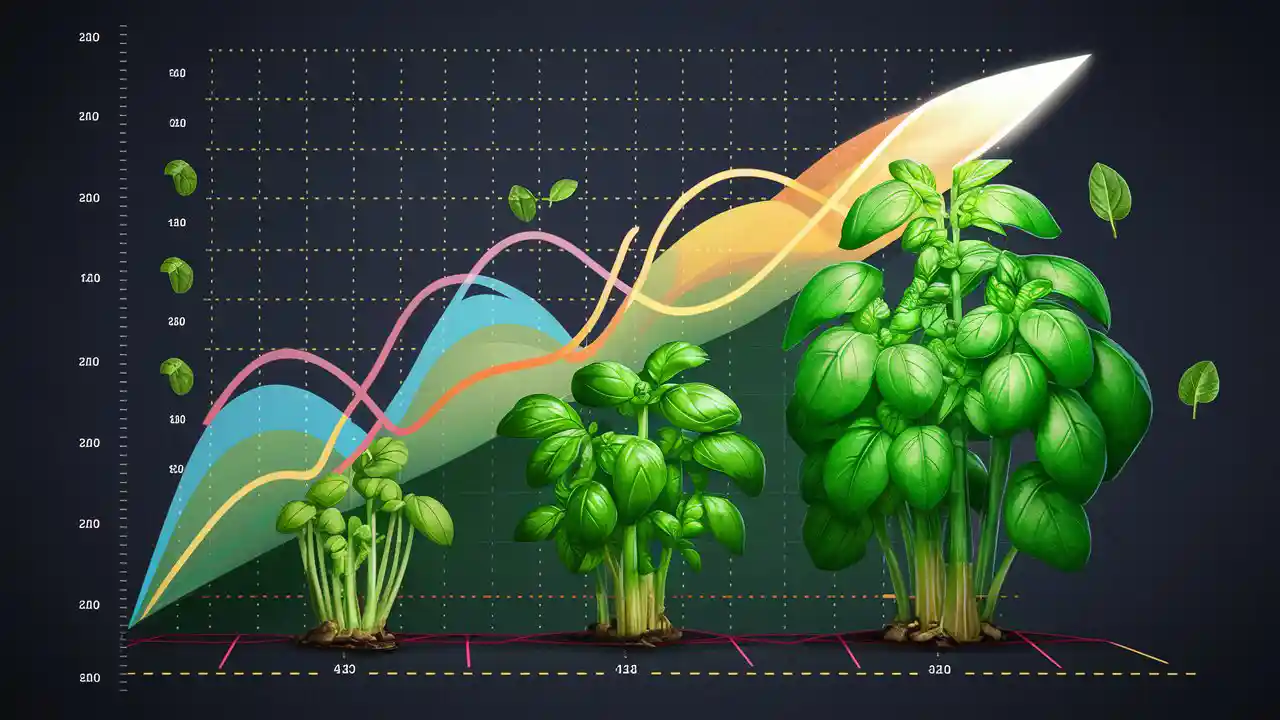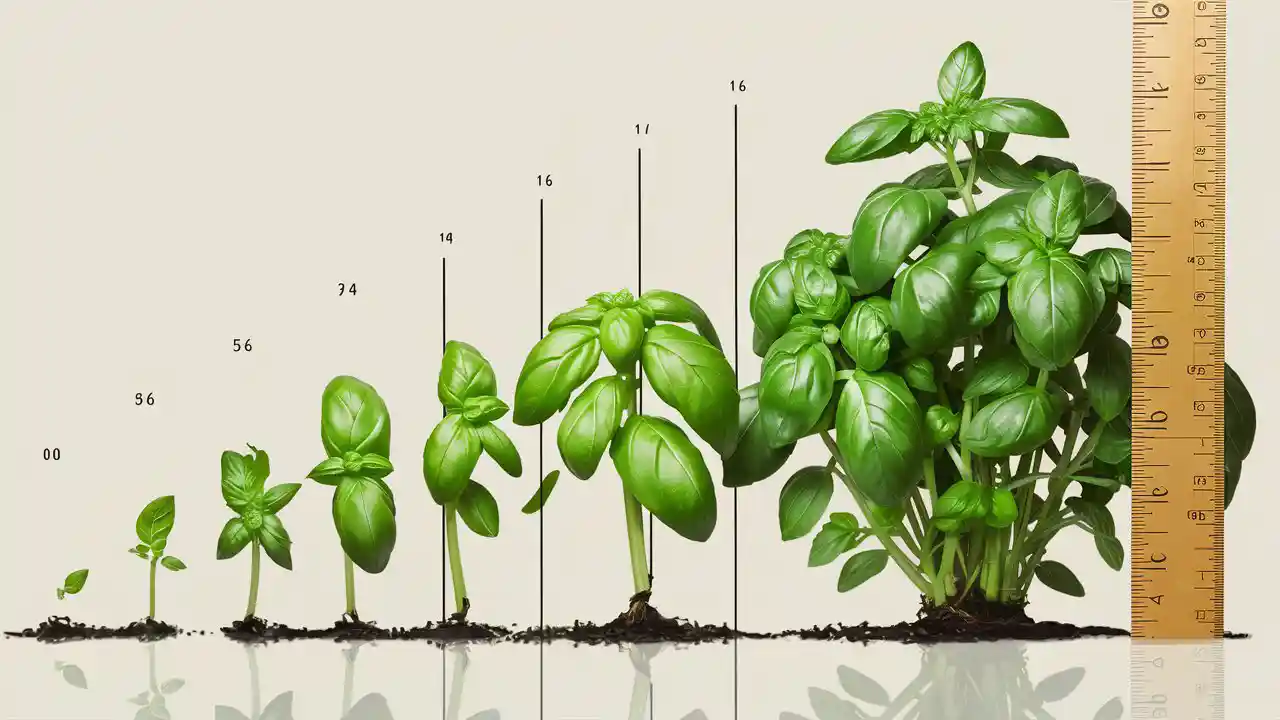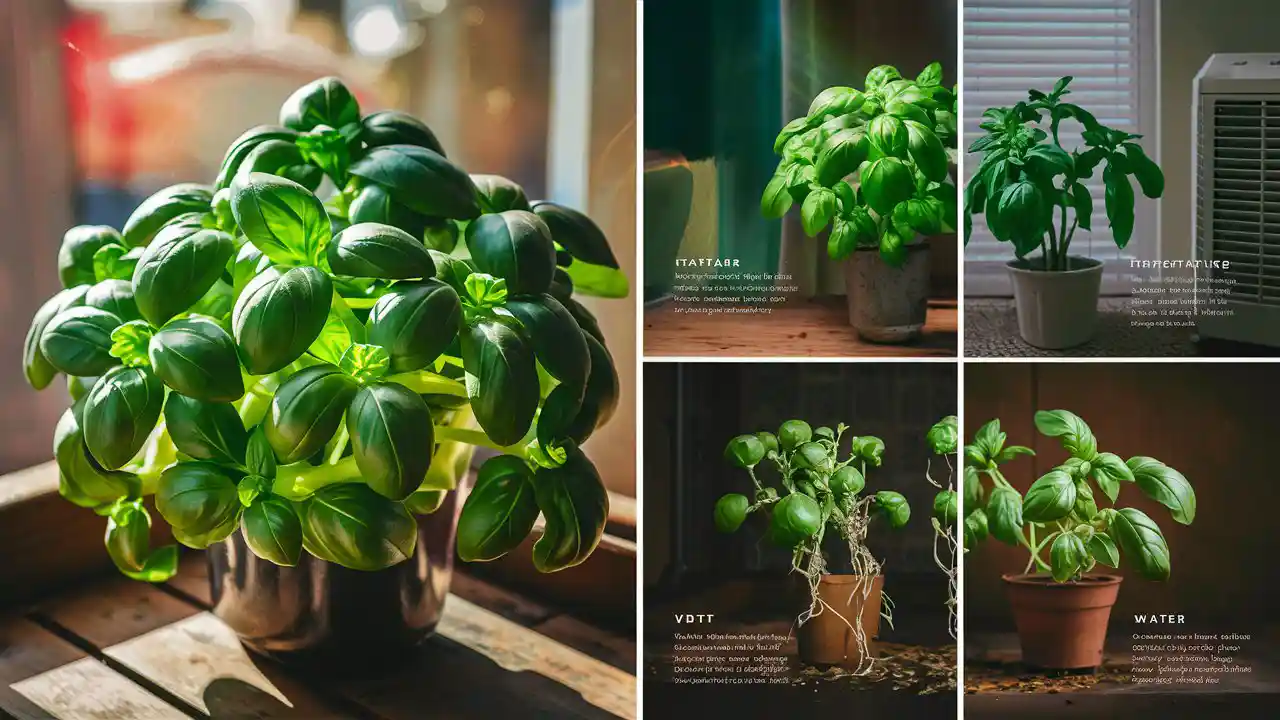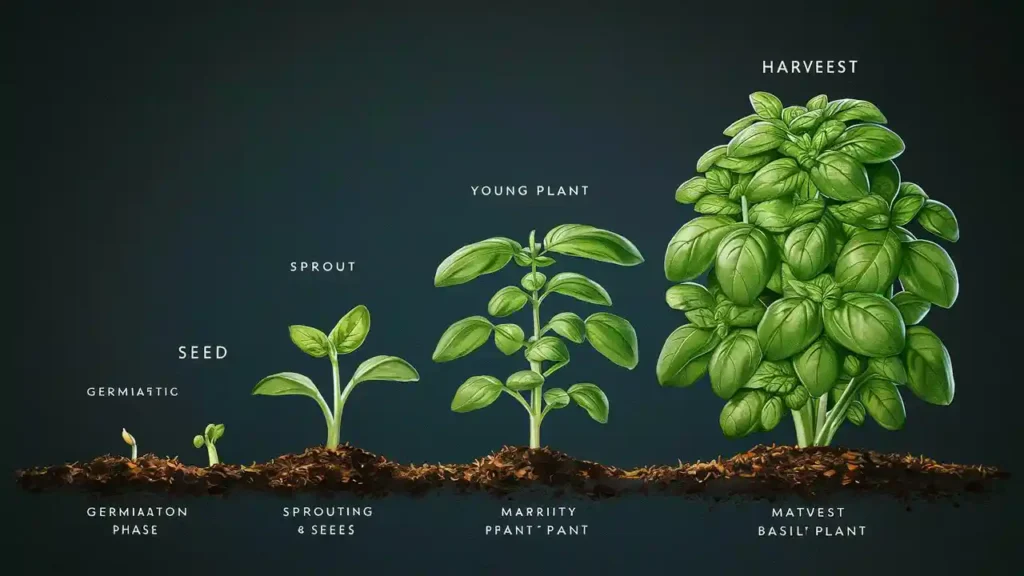How long does it take to grow basil indoors?
Basil is a fast-growing herb that can be easily grown indoors. From seed, it takes about 6-8 weeks to grow basil indoors, while from cuttings, it takes about 4-6 weeks. The time it takes to grow basil indoors can vary depending on the variety of basil, the growing conditions, and the care it receives.

Basil Growing Time Indoors
Basil is an incredibly popular herb that can easily be grown indoors, providing you with fresh, flavorful leaves all year round. The growing time for basil indoors can vary depending on the variety, growing conditions, and care you provide. However, you can generally expect to harvest your basil within 60 to 90 days from the time you sow the seeds.
The initial stage of basil growth is the germination period, which typically takes around 7 to 10 days. Once the seeds have germinated, the seedlings will begin to grow rapidly, reaching a height of 6 to 8 inches within 4 to 6 weeks. During this vegetative growth stage, the basil plants will develop their leaves and stems.
As the basil plants mature, they will enter the flowering stage, which usually occurs around 8 to 10 weeks after germination. During this stage, the plants will produce small, white flowers. It’s important to note that flowering can divert the plant’s energy away from leaf production, so it’s recommended to remove the flowers as they appear to encourage bushier growth and more leaf production.
With proper care and maintenance, your indoor basil plants can continue to produce fresh leaves for several months. By following the tips and guidelines outlined in this article, you can enjoy a thriving indoor basil garden and have a continuous supply of this aromatic herb at your fingertips.

Basil Growth Rate Indoors
The basil growth rate indoors is influenced by several factors, including light, temperature, and nutrients. Under optimal conditions, basil plants can grow rapidly, reaching a height of 6-12 inches within 6-8 weeks from germination.
Light: Basil plants require ample sunlight or artificial light to thrive. Providing 12-14 hours of light per day will promote healthy growth and prevent leggy plants.
Temperature: Basil prefers warm temperatures between 65-85°F (18-29°C). Maintaining consistent temperatures within this range will ensure optimal growth.
Nutrients: Fertilizing basil plants regularly with a balanced fertilizer will provide the necessary nutrients for healthy growth. Use a fertilizer specifically designed for herbs and follow the instructions on the package.
By providing optimal growing conditions, you can encourage a fast and healthy growth rate for your indoor basil plants.

How Long Does Basil Take to Grow Indoors?
The time it takes for basil to grow indoors can vary depending on factors such as the variety of basil, growing conditions, and care provided. However, as a general guideline, here’s an approximate timeline:
- Germination: 5-10 days
- Seedling stage: 2-3 weeks
- Vegetative growth: 4-6 weeks
- Flowering: 8-10 weeks (can be prevented by pinching off flower buds)
- Harvest: 6-8 weeks after germination
It’s important to note that these are just estimates, and the actual growth rate of your basil plants may vary. By providing optimal growing conditions, such as well-draining soil and regular watering, you can encourage healthy growth and a bountiful harvest.

Basil Germination Time Indoors
Basil seeds are relatively quick to germinate indoors, typically taking 5-10 days to sprout. To ensure optimal germination, follow these steps:
- Use fresh seeds: Older seeds may have a lower germination rate.
- Soak seeds overnight: This helps soften the seed coat and speeds up germination.
- Prepare a seed-starting mix: Use a well-draining mix specifically designed for seed-starting.
- Sow seeds shallowly: Press seeds gently into the soil, just below the surface.
- Keep soil moist: Water the soil regularly to keep it evenly moist but not waterlogged.
- Provide warmth: Basil seeds germinate best at temperatures between 70-85°F (21-29°C).
- Provide light: Once the seeds germinate, provide them with bright, indirect light.
By following these steps, you can increase the chances of successful basil germination indoors and ensure a healthy start for your indoor basil garden.
Basil Harvest Time Indoors
The time it takes for basil to reach maturity and be ready for harvest indoors varies depending on the variety and growing conditions. Generally, basil plants grown indoors can be harvested within 60 to 90 days from germination.
To determine if your basil is ready for harvest, look for the following signs:
- Leaves: The leaves should be a deep green color and have a strong, fragrant aroma.
- Size: The leaves should be at least 2 inches long and have a good shape.
- Stems: The stems should be sturdy and not woody.
When harvesting basil, it’s best to remove only the top few leaves from each plant. This will encourage new growth and prevent the plant from becoming leggy. You can harvest basil as needed, but avoid over-harvesting, as this can weaken the plant.
Once harvested, basil can be stored in the refrigerator for up to a week. To extend its shelf life, you can wrap the basil in a damp paper towel and place it in a plastic bag.

Factors Affecting Basil’s Growth Indoors
The growth rate and overall health of basil plants grown indoors can be influenced by several factors, including:
1. Light: Basil requires ample sunlight or artificial light for optimal growth. Provide at least 6-8 hours of bright, indirect light per day.
2. Temperature: Basil thrives in warm temperatures between 65-85°F (18-29°C). Avoid exposing plants to extreme cold or heat.
3. Water: Water basil plants regularly, but allow the soil to dry out slightly between waterings. Overwatering can lead to root rot.
4. Soil: Use a well-draining potting mix with a pH of 6.0-6.5. Amend the soil with organic matter like compost or peat moss to improve fertility.
5. Nutrients: Fertilize basil plants every 2-3 weeks with a balanced liquid fertilizer. Avoid overfeeding, as too much fertilizer can burn the roots.
6. Air Circulation: Good air circulation helps prevent fungal diseases and promotes healthy plant growth. Use a fan or open windows to provide ventilation.
Tips for Growing Basil Indoors
To ensure a thriving indoor basil garden, consider the following tips:
1. Choose the Right Variety: Select basil varieties suitable for indoor cultivation, such as ‘Sweet Genovese’ or ‘Lemon Basil’.
2. Provide Adequate Sunlight: Basil requires at least 6 hours of bright, indirect sunlight daily. Use grow lights if natural light is insufficient.
3. Water Wisely: Water basil plants when the soil feels slightly dry to the touch. Avoid overwatering, as it can lead to root rot.
4. Fertilize Regularly: Feed basil plants with a balanced liquid fertilizer every 2-3 weeks during the growing season.
5. Prune Regularly: Pinch back the tips of basil stems to encourage bushier growth and prevent legginess.
6. Control Pests and Diseases: Inspect basil plants regularly for pests and diseases. Use organic pest control methods, such as neem oil or insecticidal soap, if necessary.
7. Provide Good Air Circulation: Ensure proper air circulation around basil plants to prevent fungal diseases.
8. Rotate Plants: Rotate basil plants every few weeks to ensure even sunlight exposure and prevent soil compaction.
9. Harvest Regularly: Harvest basil leaves as needed, removing the top few leaves from each stem. Regular harvesting encourages new growth.
Troubleshooting Common Basil Problems Indoors
Growing basil indoors can be rewarding, but it’s not without its challenges. Here are some common problems you may encounter and how to address them:
Yellowing leaves:
This could indicate overwatering, nutrient deficiency, or insufficient sunlight. Reduce watering frequency, fertilize with a balanced fertilizer, and provide more light.
Stunted growth:
Basil needs proper lighting and nutrients to thrive. Ensure it receives at least 6 hours of sunlight or artificial light daily and fertilize regularly.
Leggy growth:
This occurs when basil stretches towards light. Provide adequate lighting, pinch back leggy stems, and rotate the plant regularly.
Pests:
Aphids, whiteflies, and spider mites can infest basil. Use insecticidal soap or neem oil to control them.
Powdery mildew:
This fungal disease causes a white powdery substance on leaves. Increase air circulation, avoid overcrowding, and use a fungicide if necessary.
Downy mildew:
This disease causes yellowing and wilting of leaves. Improve drainage, remove infected leaves, and apply a fungicide.
Bolting:
When basil produces flowers prematurely, it’s called bolting. This can be caused by stress, such as heat or drought. Keep the plant well-watered and provide adequate light.
Harvesting and Using Basil Grown Indoors
Once your basil plants have reached maturity, it’s time to harvest and enjoy the fruits of your labor. To harvest basil, simply pinch or cut the leaves from the stem as needed. You can harvest basil leaves throughout the growing season, as long as you don’t remove more than one-third of the plant’s leaves at a time.
Basil leaves can be used fresh or dried. To dry basil leaves, spread them out on a paper towel or baking sheet and place them in a warm, dry place. Once the leaves are completely dry, crumble them and store them in an airtight container. Dried basil leaves will retain their flavor for several months.
Basil is a versatile herb that can be used in a variety of dishes. It’s commonly used in Italian cooking, but it can also be added to salads, soups, stews, and even desserts. Basil’s fresh, peppery flavor adds a touch of zest to any dish.
Conclusion
Growing basil indoors is a rewarding experience that can provide you with fresh, flavorful herbs all year round. By understanding the basil growing time indoors, growth rate, germination time, and harvest time, you can ensure a successful indoor basil garden. Remember to provide your basil plants with optimal growing conditions, including plenty of sunlight, well-draining soil, and regular watering. With proper care, you can enjoy the benefits of homegrown basil for many months to come.
In summary, here are the key takeaways for growing basil indoors:
- Basil takes about 60-70 days to grow from seed to harvest indoors.
- Basil grows at a rate of about 1-2 inches per week.
- Basil seeds germinate in about 5-7 days.
- Basil plants should be harvested when they are about 6-8 inches tall.
- Factors that affect basil growth indoors include sunlight, temperature, humidity, and soil quality.
- Tips for growing basil indoors include providing plenty of sunlight, well-draining soil, and regular watering.
- Common basil problems indoors include pests, diseases, and nutrient deficiencies.
- Basil can be harvested by cutting the leaves or stems.
- Homegrown basil can be used in a variety of dishes, including salads, soups, and sauces.
With a little care and attention, you can enjoy the delicious taste of homegrown basil all year round.
Frequently Asked Questions
Q: How long does it take to grow basil indoors?
A: From seed, it takes about 6-8 weeks to grow basil indoors. From cuttings, it takes about 4-6 weeks.
Q: How fast does basil grow indoors?
A: Basil grows at a rate of about 1-2 inches per week.
Q: How long does it take for basil seeds to germinate indoors?
A: Basil seeds germinate in about 5-7 days.
Q: When should I harvest basil grown indoors?
A: Basil plants should be harvested when they are about 6-8 inches tall.
Q: What are some common problems with growing basil indoors?
A: Common basil problems indoors include pests, diseases, and nutrient deficiencies.
Q: How can I prevent basil from bolting?
A: To prevent basil from bolting, keep the plant well-watered and provide adequate light.
Q: How can I preserve basil?
A: Basil can be preserved by drying the leaves or freezing them in ice cube trays with olive oil.
Q: What are some ways to use basil?
A: Basil can be used in a variety of dishes, including salads, soups, sauces, and even desserts.
